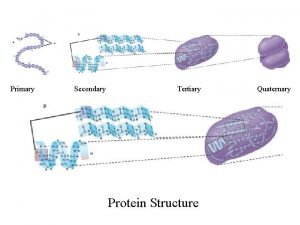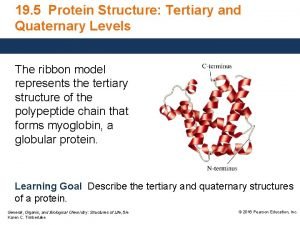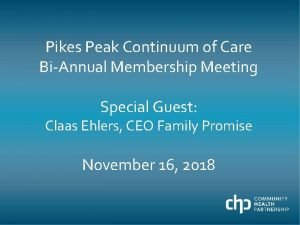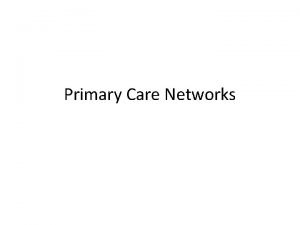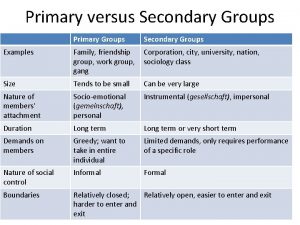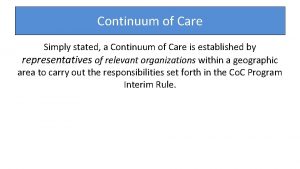Levels and Continuum of Care Primary Secondary Tertiary

































- Slides: 33

Levels and Continuum of Care

Primary, Secondary & Tertiary Care v One concept is essential in understanding the "topography" of any health care system: the organization of care into primary, secondary, and tertiary levels. v In the Lord Dawson Report, an influential British study written in 1920, the author proposed that each of the three levels of care should correspond with certain unique patient needs. 1. Primary care involves common health problems (eg, sore throats, sprained ankles, or hypertension) and preventive measures (eg, vaccinations) that account for 80%– 90% of visits to a physician or other caregiver. 2. Secondary care involves problems that require more specialized clinical expertise such as hospital care for a patient with acute renal failure. 3. Tertiary care, which lies at the apex of the organizational pyramid, involves the management of rare and complex disorders such as pituitary tumors and congenital malformations.

Different Approaches to Organization v Two contrasting approaches can be used to organize a health care system around these levels of care: 1. the carefully structured Dawson model of regionalized health care, and 2. a more free-flowing model.

Dawson model v One approach uses the Dawson model as a scaffold for a highly structured system. This model is based on the concept of regionalization: the organization and coordination of all health resources and services within a defined area. v In a regionalized system, different types of personnel and facilities are assigned to distinct tiers in the primary, secondary, and tertiary levels, and the flow of patients across levels occurs in an orderly, regulated fashion. v This model emphasizes the primary care base.

free-flowing model v An alternative model allows for more fluid roles for caregivers, and more free-flowing movement of patients, across all levels of care. v This model tends to place a higher value on services at the tertiary care apex than at the primary care base.

Mixture of Models v Although most health care systems embody elements of both models, some gravitate closer to one polarity or the other. v The British National Health Service (NHS) and a few health maintenance organizations (HMOs) in the United States resemble the regionalized approach, while United States health care as a whole traditionally followed the more dispersed format.

The Regionalized Model: The Traditional British National Health Service v Basil, a 60 -year-old man living in a London suburb, is registered with Dr. Prime, a general practitioner in his neighborhood. Basil goes to Dr. Prime for most of his health problems, including hay fever, back spasms, and hypertension. One day he experiences numbness and weakness in his face and arm. By the time Dr. Prime examines him later that day, the symptoms have resolved. Suspecting that Basil has had a transient ischemic attack, Dr. Prime prescribes aspirin and refers him to the neurologist at the local hospital, where a carotid artery sonogram reveals high-grade carotid stenosis. Dr. Prime and the neurologist agree that Basil should make an appointment at a London teaching hospital with a vascular surgeon specializing in head and neck surgery. The surgeon recommends that Basil undergo carotid endarterectomy on an elective basis to prevent a major stroke. Basil returns to Dr. Prime to discuss this recommendation and inquires whether the operation could be performed at a local hospital closer to home. Dr. Prime informs him that only a handful of London hospitals are equipped to perform this type of specialized operation. Basil schedules his operation in London and several months later has an uncomplicated carotid endarterectomy. Following the operation, he returns to Dr. Prime for his ongoing care

Dowson Model Organization of services under the traditional National Health Service model in the United Kingdom. Care is organized into distinct levels corresponding to specific functions, roles, administrative units, and population bases

The Regionalized Model 1. For physician services, the primary care level is virtually the exclusive domain of general practitioners (commonly referred to as GPs), who practice in small to mediumsized groups and whose main responsibility is ambulatory care. Two-thirds of all physicians in the United Kingdom are GPs. 2. The secondary tier of care is occupied by physicians in such specialties as internal medicine, pediatrics, neurology, psychiatry, obstetrics and gynecology, and general surgery. These physicians are located at hospital -based clinics and serve as consultants for outpatient referrals from GPs, in turn routing most patients back to GPs for ongoing care needs. Secondary-level physicians also provide care to hospitalized patients. 3. Tertiary care subspecialists such as cardiac surgeons, immunologists, and pediatric hematologists are located at a few tertiary care medical centers.

The Regionalized Model v Hospital planning follows the same regionalized logic as physician services. District hospitals are local facilities equipped for basic inpatient services. Regional tertiary care medical centers handle highly specialized inpatient care needs. v Patient flow moves in a stepwise fashion across the different tiers. v Except in emergency situations, all patients are first seen by a GP, who may then steer patients toward more specialized levels of care through a formal process of referral. Patients may not directly refer themselves to a specialist.

The Regionalized Model v While nonphysician health professionals such as nurses play an integral role in staffing hospitals at the secondary and tertiary care levels, especially noteworthy is the NHS's multidisciplinary approach to primary care. v GPs work in close collaboration with practice nurses (similar to nurse practitioners in the United States), home health visitors, public health nurses, and midwives (who attend most deliveries in the United Kingdom). v Public health nurses visit all homes in the first weeks after a birth to provide education and assist with scheduling of initial GP appointments.

The Regionalized Model v A number of other nations, ranging from industrialized countries in Scandinavia to developing nations in Latin America, have adopted a similar approach to organizing health services. v In developing nations, the primary care tier relies more on community health educators and other types of public health personnel than on physicians.

The Dispersed Model: Traditional United States Health Care Organization v Polly Seymour, a 55 -year-old woman with private health insurance who lives in the United States, sees several different physicians for a variety of problems: a dermatologist for eczema, a gastroenterologist for recurrent heartburn, and an orthopedist for tendinitis in her shoulder. She may ask her gastroenterologist to treat a few general medical problems, such as borderline diabetes. On occasion, she has gone to the nearby hospital emergency room for treatment of urinary tract infections. One day Polly feels a lump in her breast and consults a gynecologist. She is referred to a surgeon for biopsy, which indicates cancer. After discussing treatment options with Polly, the surgeon performs a lumpectomy and refers her to an oncologist and radiation therapy specialist for furtherapy. She receives all of these treatments at a local hospital a short distance from her home.

The Dispersed Model v The United States health care system has had a far less structured approach to levels of care than the British NHS. v In contrast to the stepwise flow of patient referrals in the United Kingdom, insured patients in the United States such as Polly Seymour have traditionally been able to refer themselves and enter the system directly at any level. Rather than having a designated primary care physician (PCP) to initially evaluate all of their problems, patients in the United States have become accustomed to taking their symptoms directly to the specialist of their choosing.

The Dispersed Model v Physicians in the United States have less clearly defined roles than physicians in systems such as the NHS. v Primary care, rather than being a unique niche for GPs and nonphysician primary providers, has become integrated into the practices of many specialist physicians. v This diffuse approach to primary care was partly born out of necessity, as only 13% of physicians in the United States are general or family practitioners. The relative decline in the numbers of these practitioners has been a steady trend since 1940, when three-fourths of physicians were GPs.

The Dispersed Model v One unique aspect of the United States approach to primary care has been to broaden the role of internists and pediatricians. v Whereas general internists and general pediatricians in the United Kingdom and most European nations serve principally as referral physicians in the secondary tier, their United States counterparts share in providing primary care. v GPs and family physicians in the United States have taken on a number of secondary care functions by providing substantial amounts of inpatient care.

The Dispersed Model v Including general internists and general pediatricians, the total supply of generalists amounts to about one-third of all physicians in the United States, a number well below the 50% or more found in Canada and many European nations. v Instead of a pyramidal system featuring a large number of general community hospitals at the base and a limited number of tertiary care referral centers at the apex, hospitals in the United States each aspire to offer the latest in specialized care. v In most urban areas, for example, several hospitals perform open heart surgery, organ transplants, radiation therapy, and high-risk obstetric procedures.

Which Model Is Right? v Critics of the United States health care system find fault with its "top-heavy" specialist and tertiary care orientation and lack of organizational coherence. v Analyses of health care in the United States over the past half century abound with such descriptions as "a nonsystem with millions of independent, uncoordinated, separately motivated moving parts, " "fragmentation, chaos, and disarray, " and "uncontrolled growth and pluralism verging on anarchy". v The high cost of health care has been attributed in part to this organizational disarray. Quality of care may suffer also. For example, when many hospitals each perform small numbers of surgical procedures such as coronary artery bypass grafts, mortality rates are higher than when such procedures are regionalized in a few higher-volume centers ().

Which Model Is Right? v Defenders of the dispersed model reply that pluralism is a virtue, promoting flexibility and convenience in the availability of facilities and personnel. §. . . nostalgia for Marcus Welby competes with the Mayo Clinic syndrome. . [Americans] may love their family doctor, but the phrase "the best in his field" has a powerful allure (). v Similarly the desire for the latest in hospital technology located a convenient distance from home competes with plans to regionalize tertiary care services at a limited number of hospitals.

Balancing the Different Levels of Care v Dr. Billie Ruben completed her residency training in internal medicine at a major university medical center. v Like most of her fellow residents, she went on to pursue subspecialty training, in her case gastroenterology. Dr. Ruben chose this career after caring for a young woman who developed irreversible liver failure following toxic shock syndrome. v After a nerve-racking touch-and-go effort to secure a donor liver, transplantation was performed and the patient made a complete recovery.

Balancing the Different Levels of Care v Upon completion of her training, Dr. Ruben joined a growing subspecialty practice at Atlantic Heights Hospital, a successful private hospital in the city. v Even though the metropolitan area of 2 million people already has two liver transplant units, Atlantic Heights has just opened a third such unit, feeling that its reputation for excellence depends on delivering tertiary care services at the cutting edge of biomedical innovation. v In her first 6 months at the hospital, Dr. Ruben participates in the care of only two patients requiring liver transplantation. Most of her patients seek care for chronic, often ill-defined abdominal pain and digestive problems. At times she wishes she had experienced more general medicine during her training.

Balancing the Different Levels of Care v In an article entitled "The Ecology of Medical Care" published over 4 decades ago, Kerr White recorded the monthly prevalence of illness for a general population of 1000 adults. v In this group, 750 experienced one or more illnesses or injuries during the month. Of these patients, 250 visited a physician at least once during the month, nine were admitted to a hospital, and only one was referred to a university medical center.

Balancing the Different Levels of Care v Serious questions can be raised about the nature of the average medical student's experience, and perhaps that of some of his clinical teachers, with the substantive problems of health and disease in the community. v In general, this experience must be both limited and unusually biased if, in a month, only 0. 0013 of the "sick" adults. . . or 0. 004 of the patients. . . in a community are referred to university medical centers. . Medical, nursing, and other students of the health professions cannot fail to receive unrealistic impressions of medicine's task in contemporary Western society. . ().

White’s Study

White’s Study

Defining Practitioner Roles v Because primary care concentrates on "common problems that are common, " there is a tendency to consider it routine and not requiring special expertise. v This notion is increasingly being challenged. Barbara Starfield is a leading proponent of the need to train generalist physicians (ie, family physicians, general internists, and GPs) specifically to fill the primary care niche. In her view: §. . . the goals of primary care better served by practitioners trained and organized to provide primary care than by practitioners trained to focus on particular illnesses, organ systems, or pathogenetic mechanisms.

Defining Practitioner Roles v Just as an invasive cardiologist must master the skills needed to perform coronary angioplasty, special competencies are required of primary care practitioners. Dr. Starfield has formulated the key tasks of primary care as follows: 1. first contact care, 2. longitudinality, 3. comprehensiveness, and 4. coordination.

Defining Practitioner Roles v Dr. O. Titus Wells has cared for all six of Bruce and Wendy Smith's children. As a family physician whose practice includes obstetrics, Dr. Wells attended the births of all but one of the children. The Smiths' 18 -month-old daughter Ginny has had many ear infections. Even though this is a common problem, Dr. Wells finds that it presents a real medical challenge. Sometimes examination of Ginny's ears indicates a raging infection, and at other times shows the presence of middle ear fluid, which may or may not represent a bona fide bacterial infection. He tries to reserve antibiotics for clear-cut cases of bacterial otitis. v When Ginny is 2 years old Dr. Wells recommends to the Smiths that she see an otolaryngologist and audiologist to check for hearing loss and language impairment. The audiograms show modest diminution of hearing in one ear. The otolaryngologist informs the Smiths that ear tubes are an option. At Ginny's return visit with Dr. Wells he discusses the pros and cons of tube placement with the Smiths. He also uses the visit as an opportunity to encourage Mrs. Smith to quit smoking, mentioning that research has shown that exposure to tobacco smoke may predispose children to ear infections.

Defining Practitioner Roles v Dr. Wells' care of the Smith family illustrates the essential features of primary care. He is the firstcontact physician performing the initial evaluation when Ginny or other family members develop symptoms of illness. Longitudinality (or continuity) refers to sustaining a patient–caregiver relationship over time. Dr. Wells' familiarity with Ginny's condition helps him to better discern an acute infection. Comprehensiveness consists of the ability to manage a wide range of health care needs, in contrast with specialty care, which focuses on a particular organ system or procedural service. Dr. Wells' comprehensive family-oriented care makes him aware that Mrs. Smith's smoking cessation program is an important part of his treatment plan for Ginny. Coordination builds upon longitudinality. Through referral and follow-up, the primary care provider integrates services delivered by other caregivers.

Advantages of Primary Care v Several studies have found that the elements of good primary care contribute to higher patient satisfaction and better patient outcomes. For example, increased continuity is associated with greater use of preventive services, higher compliance with appointment keeping and use of medications, better outcomes for diabetic patients and pregnant women, reductions in hospitalizations, and declines in overall costs. v There is evidence that having a regular source of care results in better control of hypertension and less reliance on emergency department services. v Persons whose care meets a primary care–oriented model have better perceived access to care, are more likely to receive recommended preventive services, are more likely to adhere to treatment, and are more satisfied with their care.

Outcomes of Primary vs. Specialty Care v An unresolved question remains about the quality of care that may be provided by primary care–oriented generalist physicians as opposed to specialists oriented toward expertise in specific areas of medicine and surgery. v Many studies have found that generalists and specialists provide a comparable quality for a variety of conditions such as diabetes, hypertension, and low back pain.

Cost vs. Quality v In terms of costs, research supports the view that generalist physicians practice a less resourceintensive style of medicine than specialists and therefore may represent a more economical approach to the provision of primary care. v The most rigorously conducted cost-comparison study found that even after controlling for potential differences in severity of illness, patients with a general internist or family physician as a regular physician used fewer resources than similar patients with a specialist as a regular physician. v Other studies have shown that health care costs are higher in regions with higher ratios of specialist-togeneralist physicians.

 Primary secondary tertiary care
Primary secondary tertiary care Primary and secondary alcohol oxidation
Primary and secondary alcohol oxidation Primary and secondary tertiary sources
Primary and secondary tertiary sources Primary secondary tertiary quaternary structure
Primary secondary tertiary quaternary structure Primary processing of wheat
Primary processing of wheat Primary secondary and tertiary sector
Primary secondary and tertiary sector Primary secondary and tertiary economic activities
Primary secondary and tertiary economic activities Business secondary sector
Business secondary sector Sewage treatment primary secondary and tertiary
Sewage treatment primary secondary and tertiary Primary secondary and tertiary protein structure
Primary secondary and tertiary protein structure Respiratory membrane
Respiratory membrane Primary secondary and tertiary bronchi
Primary secondary and tertiary bronchi Pleura
Pleura What is a tertiary consumer
What is a tertiary consumer What are primary secondary and tertiary industries
What are primary secondary and tertiary industries Is fishing primary secondary or tertiary
Is fishing primary secondary or tertiary Primary secondary and tertiary structure of protein
Primary secondary and tertiary structure of protein Wastewater treatment process primary secondary tertiary
Wastewater treatment process primary secondary tertiary What colors are located next to each other on the wheel
What colors are located next to each other on the wheel Weber's least cost theory
Weber's least cost theory Level of education in malaysia
Level of education in malaysia Levels of economic activity worksheet
Levels of economic activity worksheet Primary secondary tertiary carbons
Primary secondary tertiary carbons Primary secondary tertiary quaternary
Primary secondary tertiary quaternary Aromatic amines structure
Aromatic amines structure Primary prevention secondary prevention tertiary prevention
Primary prevention secondary prevention tertiary prevention Primary secondary tertiary
Primary secondary tertiary Primary activities and secondary activities
Primary activities and secondary activities Asam continuum of care
Asam continuum of care Summit county continuum of care
Summit county continuum of care Care continuum prior authorization
Care continuum prior authorization Pikes peak continuum of care
Pikes peak continuum of care Continuum care greensboro nc
Continuum care greensboro nc Big bend continuum of care
Big bend continuum of care



